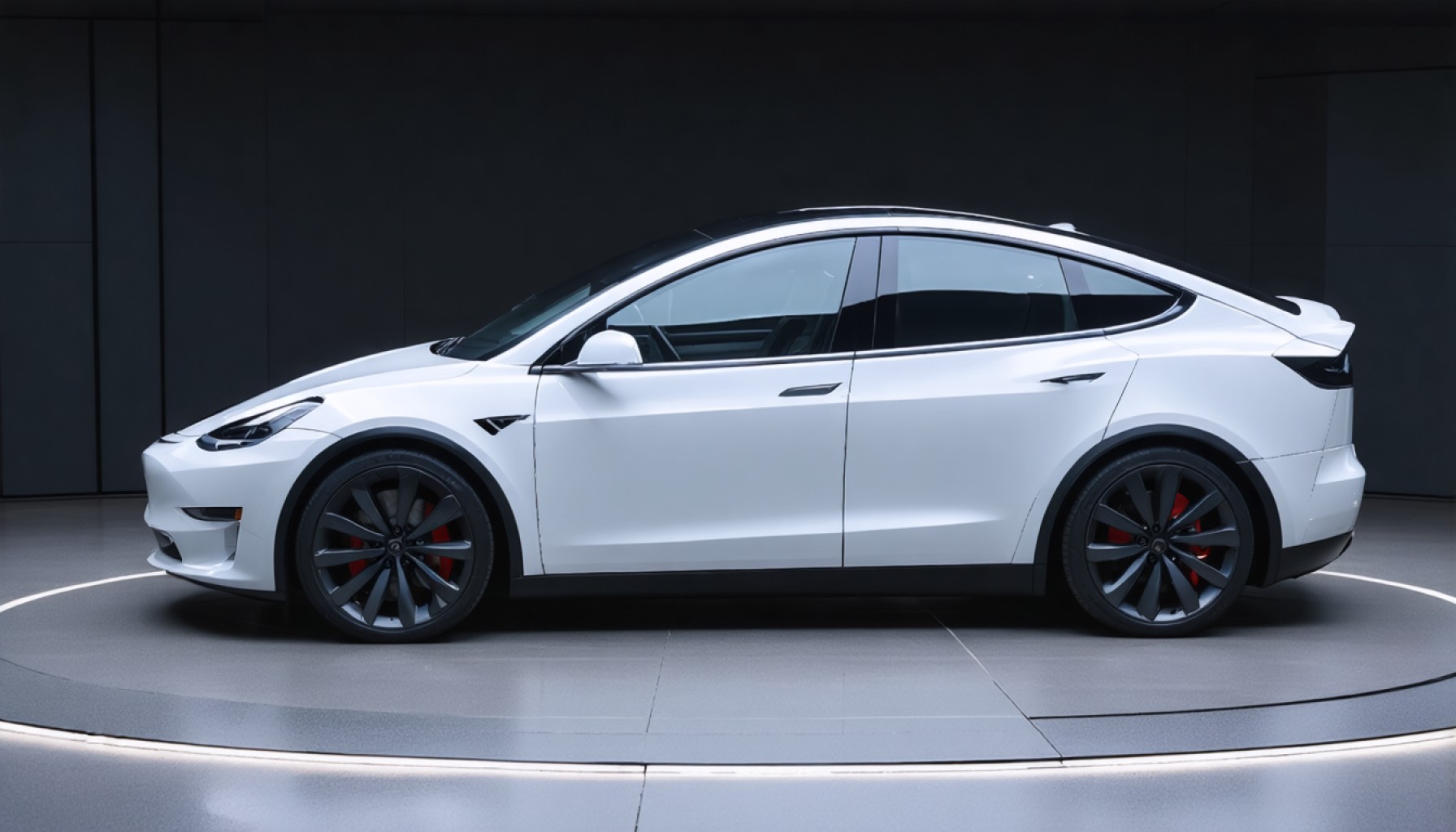- New Tesla registrations in Europe have dropped by 49% in the year’s first two months, totaling 19,046 vehicles.
- The decline contrasts with a 28.4% rise in overall electric vehicle sales across the EU during the same period.
- Tesla’s Model 3 and Model Y face intense competition from European and Chinese manufacturers offering innovative vehicles.
- Elon Musk’s political affiliations have sparked disapproval, impacting Tesla’s brand image in Europe, particularly in Germany.
- Internal challenges include reliability concerns and mass recalls, exacerbating Tesla’s difficulties in the European market.
- Tesla must strategically recalibrate to address shifting consumer preferences and maintain its industry presence.
A storm is gathering over Tesla’s once-unassailable presence in the European market, with registration numbers reflecting a precipitous decline. In a startling shift, new Tesla registrations plummeted by 49% in the first two months of this year, totalling just 19,046 vehicles, contrasting sharply with a significant rise in overall electric vehicle sales across the EU. This divergence highlights a curious disconnect between the brand and its consumer base, raising questions about Tesla’s trajectory in an increasingly competitive and volatile market.
As electric vehicles capture the zeitgeist of European roads, Tesla’s models, once at the cutting edge, now seem to lag. The company’s stalwart offerings, the Model 3 and Model Y, are facing stiff competition from fresh European and Chinese contenders, despite their updated versions. These vehicles are rapidly reshaping the landscape with innovative features and compelling designs, leaving Tesla to contend with a diminished allure.
Beyond the showroom, Tesla’s decline is also intertwined with the charismatic yet polarizing figure of Elon Musk. His visible support for Germany’s far-right Alternative for Germany (AfD) party in recent elections has sparked widespread disapproval, resonating like a seismic wave across the continent. The choice has left a trail of scorched Tesla cars in Germany—the symbolic bonfires of a more profound dissent. Even as the EU auto market strives towards zero-emission goals, the spectacle of Teslas in flames paints a vivid picture of a brand grappling with ideological backlash.
It’s not just political entanglements unsettling Tesla’s European fortress; there are internal quakes too. Reliability issues and mass recalls, even of models not yet sold in the region, add to the brand’s woes. Musk’s outspoken political views and his association with former US President Donald Trump, whose policies frequently clashed with the EU, add layers of complexity to Tesla’s declining numbers.
Yet, amid these trials, the broader electric vehicle sector is surging ahead. Registrations reflect a 28.4% increase, suggesting a robust appetite for battery vehicles across countries like Germany, Belgium, and the Netherlands. As traditional manufacturers recalibrate with improved incentives and infrastructure for green mobility, Tesla’s journey towards $1,000 shares and dominance seems outpaced by an industry marching to a different beat.
Despite Tesla’s historic role as an industry trailblazer, the shifting sands of consumer preferences and brand perception underline the urgency for its strategic recalibration. If Tesla is to regain its standing, it must navigate beyond the legacies of its pioneering past, engaging in a dance with innovation and public sentiment that defines the future of mobility itself.
In this crossroads, Tesla’s narrative is a powerful reminder of how swiftly fortunes can shift in the world of commerce—where values and vision intertwine with innovation, forging the path forward for the automotive revolution.
Will Tesla’s Star Fade in Europe’s Electric Vehicle Market?
Tesla’s decline in Europe, marked by a staggering 49% drop in new registrations during the first two months of the year, raises fundamental questions about the brand’s once-dominant position. As the larger electric vehicle (EV) market in Europe experiences growth, Tesla’s diminishing share suggests a disconnect that needs urgent addressing. This article dives deeper into the factors behind Tesla’s woes, explores the competitive landscape, and provides actionable insights and recommendations for navigating this volatile market.
The Competitive Landscape and Shifting Consumer Preferences
1. Emergence of European and Chinese Competitors: Tesla’s Model 3 and Model Y, once synonymous with innovation, are now being challenged by new entrants. European manufacturers like Volkswagen (VW ID. series) and newer Chinese brands such as NIO and BYD are offering vehicles with similar or superior features and design aesthetics at competitive prices. Volkswagen
2. Rising Demand for Diverse EVs: The European market is hungry for variety, as consumers now prioritize not only performance but also sustainability, aesthetics, and brand values. Companies like Hyundai with the Ioniq series and Kia with its EV range have made significant inroads.
3. Brand Perception and Reputation: Elon Musk’s political entanglements, particularly his support for the far-right in Germany, have negatively impacted Tesla’s brand image. Consumers are increasingly aligning purchases with personal and societal values.
Internal Challenges for Tesla
– Reliability Concerns and Recalls: Recurring reliability issues and vehicle recalls are eroding consumer trust. Tesla must address these technical challenges swiftly to restore confidence.
– EU Market Strategy: Tesla’s market approach needs to emphasize customization and localized models to cater to diverse European preferences, much like its competitors do.
Actionable Insights for Tesla
1. Strengthen Customer Relations: Tesla can rebuild trust by enhancing its customer service, addressing reliability issues transparently, and engaging directly with its European customer base to understand and meet their expectations.
2. Product Revitalization: Continuous innovation in battery technology, autonomous driving capabilities, and design enhancements are essential. Investing in R&D and local partnerships in Europe could accelerate these efforts.
3. Improve Charging Infrastructure: Expanding the Supercharger network and collaborating with European charging networks can improve Tesla’s appeal, addressing one of the most significant reluctances towards EV adoption.
4. Tailored Marketing Campaigns: Crafting marketing strategies that resonate with European values and cultural nuances, distancing from political controversies, can improve brand perception.
Looking Ahead: Market Forecasts & Industry Trends
– Growth of Electric Vehicle Sales: The European EV market is expected to grow at a compound annual growth rate (CAGR) of 26% through 2025, reflecting ongoing governmental incentives and growing consumer environmentalism. Participation in this growth is critical for Tesla’s European comeback.
– Advancements in Autonomous Technology: As companies race towards perfecting self-driving technology, Tesla’s strategic advantage in this domain could be leveraged more aggressively if technological milestones are achieved.
– Potential for Strategic Partnerships: Collaborative ventures with European tech firms or automotive companies might bolster Tesla’s market standing, offering supply chain benefits and localized expertise.
Quick Tips for Investors and Enthusiasts
– Monitor New Entrants: Stay informed about emerging competitors and their offerings as they alter market dynamics.
– Assessing Brand Moves: Pay attention to Tesla’s product announcements, strategic pivots, and management changes for early indications of its market recalibration efforts.
– Leverage Policy Changes: Be aware of EU policy shifts regarding emissions and EV incentives which can influence market conditions.
Tesla’s journey in Europe is a testament to the rapid evolution of the auto industry, where innovation and public sentiment are as important as pioneering legacy. As Tesla recalibrates its strategy, it serves as a tale of caution and an opportunity for growth in the ever-expanding electric vehicle landscape.







